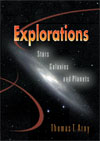Orbiting the Sun and scattered throughout the Solar System are numerous bodies
much smaller than the planets the asteroids and comets. The asteroids are generally
rocky objects in the inner Solar System. The comets are icy bodies and spend
most of their time in the outer Solar System. These small members of the Sun's
family, remnants from the formation of the Solar System, are of great interest
to astronomers because they are our best source of information about how long
ago and under what conditions the planets formed. In fact, some asteroids and
comets may be planetesimals the solid bodies from which the planets were assembled that
have survived nearly unchanged from the birth of the Solar System. Apart from their scientific value, asteroids and comets merit study because
they can be both beautiful and deadly. A comet in the dawn sky with its tail
a shining plume is a sight not to miss. But "miss" is precisely what
we hope will happen if a large comet or asteroid is on a collision course with
Earth. Such a collision in the past may have exterminated much of Earth's ancient
life, and such an event in the future could well have equally disastrous effects
on today's living things. In this chapter, we will see why astronomers think asteroids and comets
are related to planetesimals. We will also discover why meteorites, fragments
of these bodies that by chance fall into our atmosphere, are such important
clues to the time of birth and the structure of the ancient Solar System. Likewise,
we will study how a comet changes from a 10-kilometer diameter ball of ice into
a beautiful banner of light in the night sky and why an asteroid may be the
reason you have hair rather than scales. | 


 2002 McGraw-Hill Higher Education
2002 McGraw-Hill Higher Education